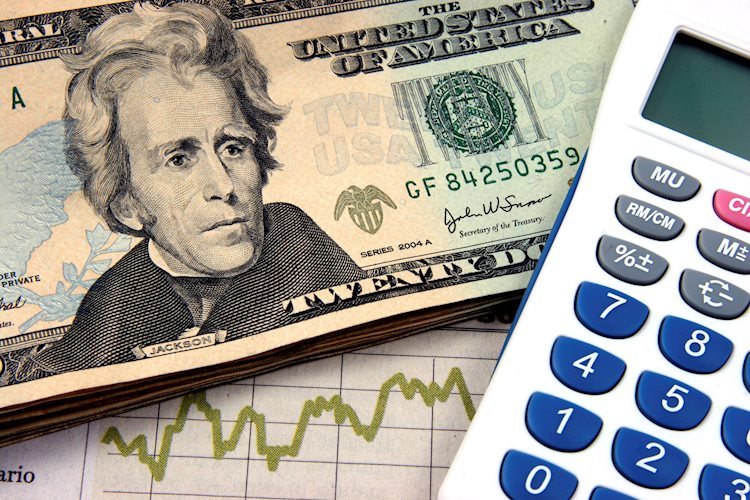
- The DXY Index recorded losses in Wednesday’s session, falling toward 104.70.
- Investors are taking profits from Tuesday’s rally following CPI.
- Focus now shifts to Retail and PPI data from January.
The US Dollar (USD) measured by the Dollar Index (DXY) experienced a dip on Wednesday as it declined near 104.70. This downward trajectory is primarily attributed to investors securing gains following the Greenback’s rally on Tuesday following January CPI results showing stubborn inflation. This fueled a recalibration of the Federal Reserve’s (Fed) rate easing expectations. For the remainder of the week, markets will eye the Producer Price Index (PPI) and Retail Sales to continue placing their bets on the next Fed decisions.
There is a growing market consensus that the Fed is unlikely to cut rates in the near term, supported by hot inflation data releases and cautious Fed officials. This adjustment in easing expectations will likely lend further strength to the USD after this consolidation. As for now, markets are delaying their prediction of the start of the easing cycle to June.
Daily digest market movers: US Dollar takes a breather to consolidate CPI gains
- No relevant reports were released by the US during the session.
- On Friday, the US will release January’s Retail Sales and Producer Price Index figures, which may provide additional volatility to the USD.
- US Treasury bond yields also consolidated. Current rates place the 2-year yield at 4.56%, the 5-year yield at 4.22%, and the 10-year yield at 4.25%, which made the US Dollar struggle to find demand on Wednesday
- According to the CME FedWatch Tool, the odds of a cut at the May meeting have significantly declined, and markets are now pushing the start of the easing cycle to June. A hold at the March meeting is now the mainstream view.
Technical analysis: DXY bull’s momentum eases, but buyers are still in control
The Relative Strength Index (RSI) on the daily chart reflects a negative slope in positive territory. The dip in the RSI, typified by declining momentum, is indicative of reduced buying strength, which can be considered a potential sign of selling pressure. Simultaneously, the Moving Average Convergence Divergence (MACD) histogram shows flat green bars. Normally, this flat alignment would suggest a balanced state between buyers and sellers in the short term fueled by the profit-taking action of the bulls.
Despite these signals, the stronger indicator here appears to be the positioning above the 20, 100 and 200-day Simple Moving Averages (SMAs). This suggests that the overall trend remains bullish and that buyers are dominating the market in the longer term despite a potential short-term reversal.
Overall, although some pullback may be expected due to profit-taking in the short term, as reflected by the negative slope of the RSI and a flat MACD, the overall bullish trend seems to be intact with bulls maintaining substantial control.
US Dollar FAQs
The US Dollar (USD) is the official currency of the United States of America, and the ‘de facto’ currency of a significant number of other countries where it is found in circulation alongside local notes. It is the most heavily traded currency in the world, accounting for over 88% of all global foreign exchange turnover, or an average of $6.6 trillion in transactions per day, according to data from 2022.
Following the second world war, the USD took over from the British Pound as the world’s reserve currency. For most of its history, the US Dollar was backed by Gold, until the Bretton Woods Agreement in 1971 when the Gold Standard went away.
The most important single factor impacting on the value of the US Dollar is monetary policy, which is shaped by the Federal Reserve (Fed). The Fed has two mandates: to achieve price stability (control inflation) and foster full employment. Its primary tool to achieve these two goals is by adjusting interest rates.
When prices are rising too quickly and inflation is above the Fed’s 2% target, the Fed will raise rates, which helps the USD value. When inflation falls below 2% or the Unemployment Rate is too high, the Fed may lower interest rates, which weighs on the Greenback.
In extreme situations, the Federal Reserve can also print more Dollars and enact quantitative easing (QE). QE is the process by which the Fed substantially increases the flow of credit in a stuck financial system.
It is a non-standard policy measure used when credit has dried up because banks will not lend to each other (out of the fear of counterparty default). It is a last resort when simply lowering interest rates is unlikely to achieve the necessary result. It was the Fed’s weapon of choice to combat the credit crunch that occurred during the Great Financial Crisis in 2008. It involves the Fed printing more Dollars and using them to buy US government bonds predominantly from financial institutions. QE usually leads to a weaker US Dollar.
Quantitative tightening (QT) is the reverse process whereby the Federal Reserve stops buying bonds from financial institutions and does not reinvest the principal from the bonds it holds maturing in new purchases. It is usually positive for the US Dollar.